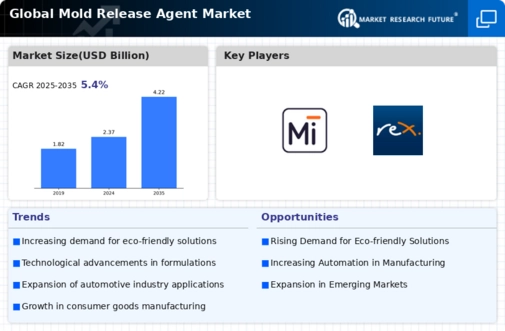Top Industry Leaders in the Mold Release Agent

In the bustling world of manufacturing, where flawless products emerge from the crucible of molds, mold release agents stand as silent guardians against friction and imperfection. These unsung heroes ensure smooth separation, safeguarding product quality and production efficiency across diverse industries. This upward trajectory is orchestrated by a symphony of factors: rising demand for high-precision manufacturing, advancements in material science, and an expanding array of industries harnessing the power of molds. But beneath this seemingly slick surface lies a complex competitive landscape, where leading players compete for market share, employing distinct strategies and navigating dynamic currents of change.
Strategies Lubricating the Path to Success:
-
Product Innovation: Leading players like Chem-Trend, Dow Corning, and Henkel are constantly pushing the boundaries of mold release technology, developing new formulations with enhanced release efficiency, environmental compatibility, and ease of application. -
Sustainability Focus: With environmental concerns gaining traction, companies are investing in bio-based mold release agents, exploring renewable feedstocks and minimizing emissions from traditional solvent-based options. -
Vertical Integration: Some players are pursuing vertical integration, acquiring raw material suppliers or expanding into downstream production of specialized mold release equipment or customized application protocols. -
Geographical Expansion: Emerging markets like China, India, and Southeast Asia offer immense potential. Companies are establishing production facilities and distribution networks in these regions to capture the surging demand for high-quality products. -
Partnerships and Acquisitions: Strategic partnerships and acquisitions are a common strategy to access new technologies, regional expertise, and customer bases, amplifying reach and capabilities.
Factors Dictating Market Share:
-
Release Efficiency and Durability: Mold release agents must effectively prevent sticking while remaining intact for multiple production cycles to maximize efficiency and reduce waste. -
Material Compatibility and Versatility: A diverse portfolio catering to a variety of mold materials and processing conditions allows companies to attract a wider customer base across industries. -
Cost-Effectiveness and Environmental Impact: Balancing affordability with responsible manufacturing practices and reduced environmental footprint is crucial for gaining customer preference. -
Brand Reputation and Technical Expertise: Established brands with a strong reputation for quality and reliable mold release solutions often enjoy market loyalty and a larger share of the pie. -
Regulatory Compliance: Meeting stringent environmental and safety regulations, particularly in Europe and North America, is crucial for market access and customer trust.
Key Players:
- Chem‑Trend L.P. US
- Michelman, inc. US
- Henkel AG & Co. KGaA Germany
- Wacker Chemie AG Germany
- Croda International Plc UK
- DAIKIN INDUSTRIES Ltd japan
- Shin-Etsu Chemical Co., Ltd Japan
- McGee Industries, Inc. US
- Cresset Chemical US
- Grignard Company, LLC US
- REXCO (US)
- Marbocote Ltd UK
- CHUKYO Europe
- GmbH Germany
Recent Developments:
-
July 2023: The U.S. Department of Energy awarded grants to research and develop next-generation mold release agents for additive manufacturing, opening doors for wider adoption in the 3D printing industry. -
August 2023: A consortium of mold release agent manufacturers launched a research initiative to develop new recycling technologies for used mold release materials, addressing waste management concerns and promoting circular economy practices. -
September 2023: Several mold release agent producers announced price increases due to rising raw material costs and supply chain disruptions. -
October 2023: The American Society of Mechanical Engineers hosted its annual conference, focusing on advancements in mold release technology, sustainability initiatives, and market trends in various manufacturing industries. -
November 2023: A global study highlighted the potential of functionalized mold release agents with enhanced properties like self-healing or anti-corrosion functionalities

